LNG–Air Mixture as a Supplementary Energy Injection into a Biogas Distribution Network
Abstract
:1. Introduction
2. Theoretical Analysis
2.1. Interchangeability of Biogas with Methane-Air
2.2. Flammability of the Methane-Air Mixed Gas
2.2.1. Explosive Limits of Methane-Air
2.2.2. Explosive Limits of the Total Mixture
3. Experimental Setup
3.1. A Pilot Blending System
3.2. Combustion Experimental Rigs
4. Results
4.1. Experimental Results of Blending
4.2. Experimental Results of Combustion
4.2.1. Flame Shape
4.2.2. Flame Stabilization
5. Conclusions
- According to the interchangeability analysis of the WI and CP indices, the security assessment on the total mixture explosion limits, as well as the adaptability analysis of combustion performance, an optimum gas mixing scheme with a methane/air ratio in the range of 49:51–53:47 was obtained.
- The mixer–ejector exhaust experiment indicated that the methane/air ratio increased with a decrease in the inlet pressure and an increase in the outlet pressure. In addition, a minimum injection pressure of 0.25 MPa was recommended to ensure that the oven former pressure met the regulation requirements. Under the same injection pressure, the pressure difference between the mixer–ejector declined with the outlet pressure, which led to less pressure energy being devoted to air entrainment. Conversely, the air fraction in the mixture rose with increasing inlet pressure.
- Similar yellow-tipping and lifting limits were observed regardless of the methane/air ratio. The lifting critical curve decreased with the primary air coefficient, but the yellow-tipping curve increased with the primary air ratio. However, there was an obvious difference between the excessive CO content curves of the two tested gases. The CO content limits of the comparative gas moved right versus the substitute gas, so that a smaller stable flame zone was obtained.
- The methane/air mixture could be fully interchanged with the 6T biogas due to the wide flame limits of stability under which perfect combustion performance and emission behavior were achieved.
Acknowledgments
Author Contributions
Conflicts of Interest
References
- Bond, T.; Templeton, M.R. History and future of domestic biogas plants in the developing world. Energy Sustain. Dev. 2011, 15, 347–354. [Google Scholar] [CrossRef]
- Cheng, S.K.; Li, Z.F.; Shih, J.; Du, X.L.; Xing, J.J. A field study on acceptability of 4-in-1 biogas systems in Liaoning Province, China. Energy Procedia 2011, 5, 1382–1387. [Google Scholar] [CrossRef]
- Wang, X.H.; Di, C.L.; Hu, X.Y.; Wu, W.M.; Jiang, X.P.; Jiang, S.Y. The influence of using biogas digesters on family energy consumption and its economic benefit in rural areas-comparative study between Liangshui and Guichi in China. Renew. Sustain. Energy Rev. 2007, 11, 1382–1387. [Google Scholar]
- Deng, Y.F.; Xu, J.P.; Liu, Y.; Mancl, K. Biogas as a sustainable energy source in China: Regional development strategy application and decision making. Renew. Sustain. Energy Rev. 2014, 35, 294–303. [Google Scholar] [CrossRef]
- Willem, V.G.; Wang, G.H. Microanalysis of the benefits of China’s family-size bio-digesters. Energy 2010, 35, 4457–4466. [Google Scholar]
- Han, J.Y.; Mol, A.P.J.; Lu, T.L.; Zhang, L. Small-scale bioenergy projects in rural China: Lessons to be learnt. Energy Policy 2008, 36, 2154–2162. [Google Scholar] [CrossRef]
- Wang, X.; Lu, X.; Yang, G.; Feng, Y.; Ren, G.; Han, X. Development process and probable future transformations of rural biogas in China. Renew. Sustain. Energy Rev. 2016, 55, 703–712. [Google Scholar] [CrossRef]
- Wu, B.; Zhang, X.; Bao, D.; Zhang, S.; Zheng, T. Energetic-environmental-economic assessment of the biogas system with three utilization pathways: Combined heat and power, biomethane and fuel cell. Bioresour. Technol. 2016, 214, 722–728. [Google Scholar] [CrossRef] [PubMed]
- Ontario Large Herd Operators. European Anaerobic Digestion Tour Report. 2006. Available online: http://www.lho-ontario.ca (accessed on 17 December 2017).
- Lantz, M. The economic performance of combined heat and power from biogas produced from manure in Sweden-A comparison of different CHP technologies. Appl. Energy 2012, 98, 502–511. [Google Scholar] [CrossRef]
- Advantage West Midlands. An Introduction to the Production of Biomethane Gas and Injection to the National Grid. 2011. Available online: www.advantagewm.co.uk (accessed on 17 January 2017).
- Pazera, A.; Slezak, R. Biogas in Europe: Food and beverage waste potential for biogas production. Energy Fuels 2015, 29, 4011–4021. [Google Scholar] [CrossRef]
- Chan, W.N.; Fu, Z.H.; Holtzapple, M.T. Co-digestion of swine manure and corn stove for bioenergy production in MixAlco consolidated bioprocessing. Biomass Bioenergy 2011, 35, 4134–4144. [Google Scholar] [CrossRef]
- Börjesson, M.; Ahlgren, E.O. Cost-effective biogas utilization-A modeling assessment of gas infrastructural options in a regional energy system. Energy 2012, 48, 212–226. [Google Scholar] [CrossRef]
- Dimpl, E. Small-scale Electricity Generation from Biomass, Part II: Biogas; Deutsche Gesellschaft für Technische Zusammenarbeit (GTZ)-HERA: Eschborn, Germany, 2010. [Google Scholar]
- Sun, Q.; Li, H.L.; Yan, J.Y.; Liu, L.C.; Yu, Z.X.; Yu, X.H. Selection of appropriate biogas upgrading technology—A review of biogas cleaning, upgrading and utilization. Renew. Sustain. Energy Rev. 2015, 51, 521–532. [Google Scholar] [CrossRef]
- Ruane, J.; Sonnino, A.; Agostini, A. Bioenergy and the potential contribution of agricultural biotechnologies in developing countries. Biomass Bioenergy 2010, 34, 1427–1439. [Google Scholar] [CrossRef]
- Gosens, J.; Lu, Y.L.; He, G.Z.; Bluemling, B.; Beckers, T.A.M. Sustainability effects of household-scale biogas in rural China. Energy Policy 2013, 54, 273–287. [Google Scholar] [CrossRef]
- Kulišić, B.; Par, V.; Metzler, R. Calculation of on-farm biogas potential: A Croatian case study. Biomass Bioenergy 2015, 74, 66–78. [Google Scholar] [CrossRef]
- Zhang, T.; Yang, Y.H.; Liu, L.L.; Han, Y.Y.; Ran, G.X.; Yang, G.H. Improved biogas production from chicken manure anaerobic digestion using cereal residues as co-substraces. Energy Fuels 2014, 28, 2490–2495. [Google Scholar] [CrossRef]
- Blesgen, A.; Hass, V.C. Efficient biogas production through process simulation. Energy Fuels 2010, 24, 4721–4727. [Google Scholar] [CrossRef]
- Hang, C.; Li, Y.; Bu, D.; Yang, G. Biogas yield and its relations with the duration and temperature of mixed anaerobic fermentation of livestock dungs and wheat straw. Chin. J. Appl. Ecol. 2008, 19, 1817–1822. [Google Scholar]
- Dong, F.Q.; Lu, J.B. Using solar energy to enhance biogas production from livestock residue-A case study of the Tongren biogas engineering pig farm in South China. Energy 2013, 57, 759–765. [Google Scholar] [CrossRef]
- Wang, X.H.; Feng, Z.M. Common factors and major characteristics of household energy consumption in comparatively well-off rural China. Renew. Sustain. Energy Rev. 2003, 7, 545–552. [Google Scholar]
- BP Gas; International Gas Union. Guidebook to Gas Interchangeability and Gas Quality. August 2011. Available online: http://www.igu.org (accessed on 20 July 2017).
- Tumwesige, V.; Fulford, D.; Davidson, G.C. Biogas appliances in Sub-Sahara Africa. Biomass Bioenergy 2014, 70, 40–50. [Google Scholar] [CrossRef]
- Standardization Administration of China. Classification and Essential Property of City Gas; Standard No. GB/T 13611-2006; Standardization Administration of China: Beijing, China, 12 September 2006. (In Chinese)
- Abeysekera, M.; Wu, J.; Jenkins, N.; Rees, M. Steady state analysis of gas networks with distributed injection of alternative gas. Appl. Energy 2011, 64, 991–1002. [Google Scholar] [CrossRef]
- American Gas Association. Interchangeability of Other Fuel Gases with Natural Gas; American Gas Association Research Bulletin No. 36; American Gas Association, Testing Laboratories: Cleveland, OH, USA, 1946. [Google Scholar]
- Budzianowski, W.M. A review of potential innovations for production, conditioning and utilization of biogas with multiple-criteria assessment. Renew. Sustain. Energy Rev. 2016, 54, 1148–1171. [Google Scholar] [CrossRef]
- Standardization Administration of China. Domestic Gas Cooking Appliances; Standard No. GB 16410-2007; Standardization Administration of China: Beijing, China, 21 June 2007. (In Chinese)
- Zhou, Y.; Huang, X.M.; Peng, S.N.; Li, L. Comparative study on the combustion characteristics of an atmospheric induction stove in the plateau and plain regions of China. Appl. Therm. Eng. 2017, 111, 301–307. [Google Scholar] [CrossRef]


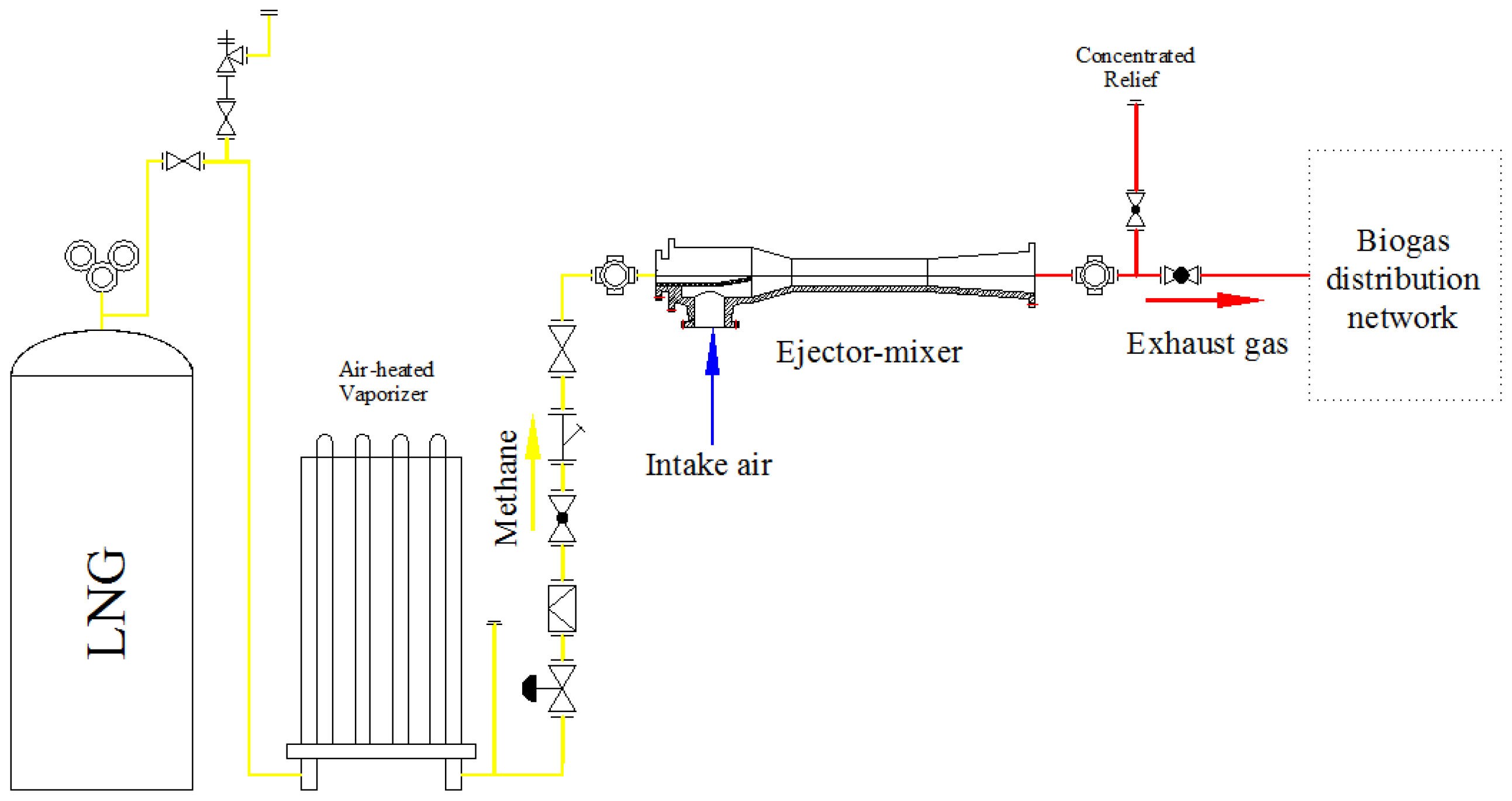

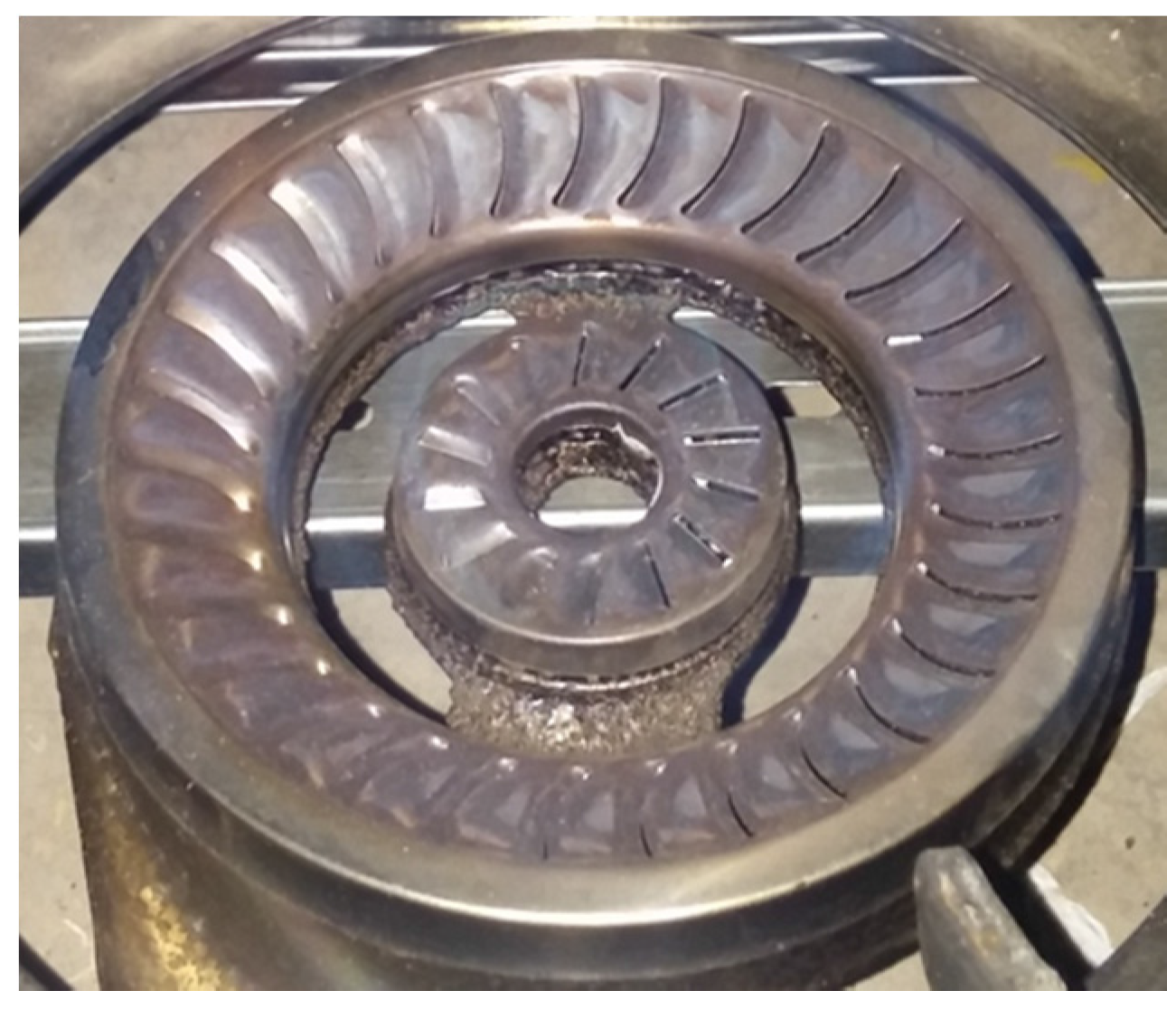
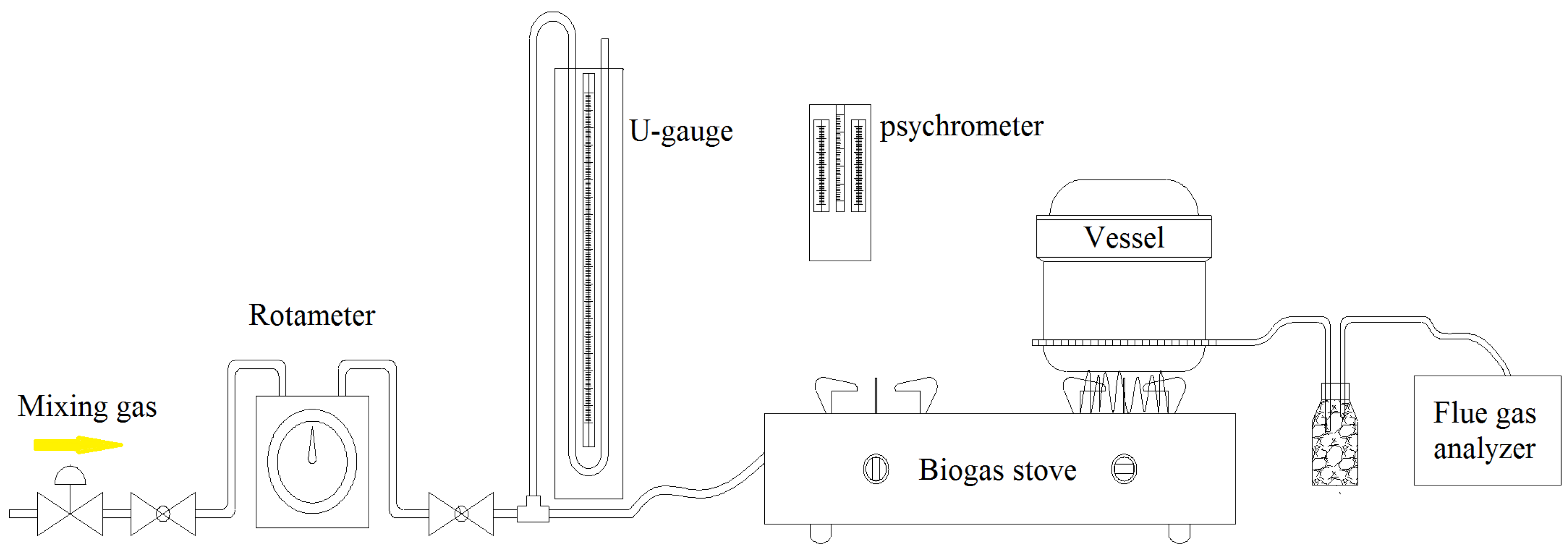
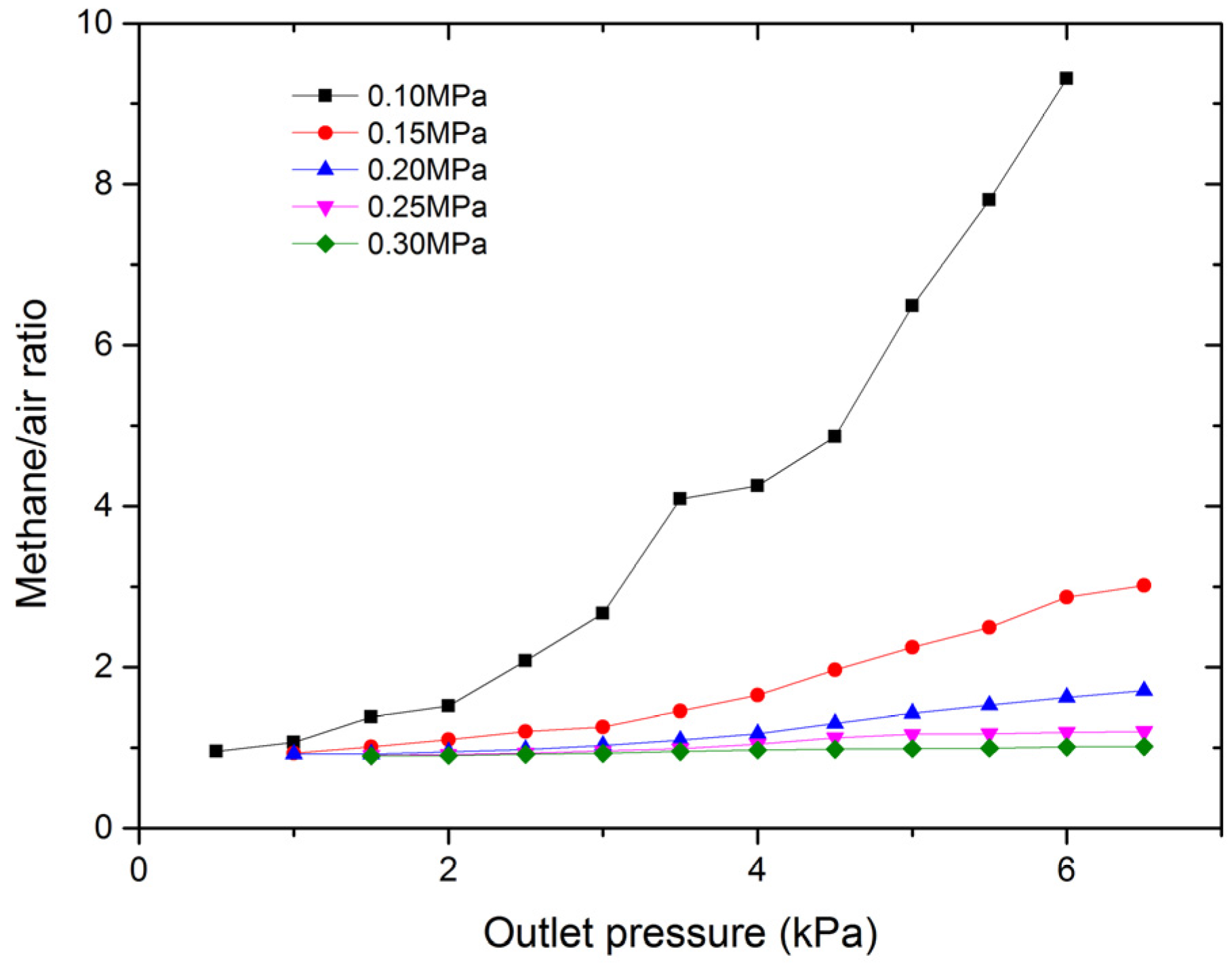

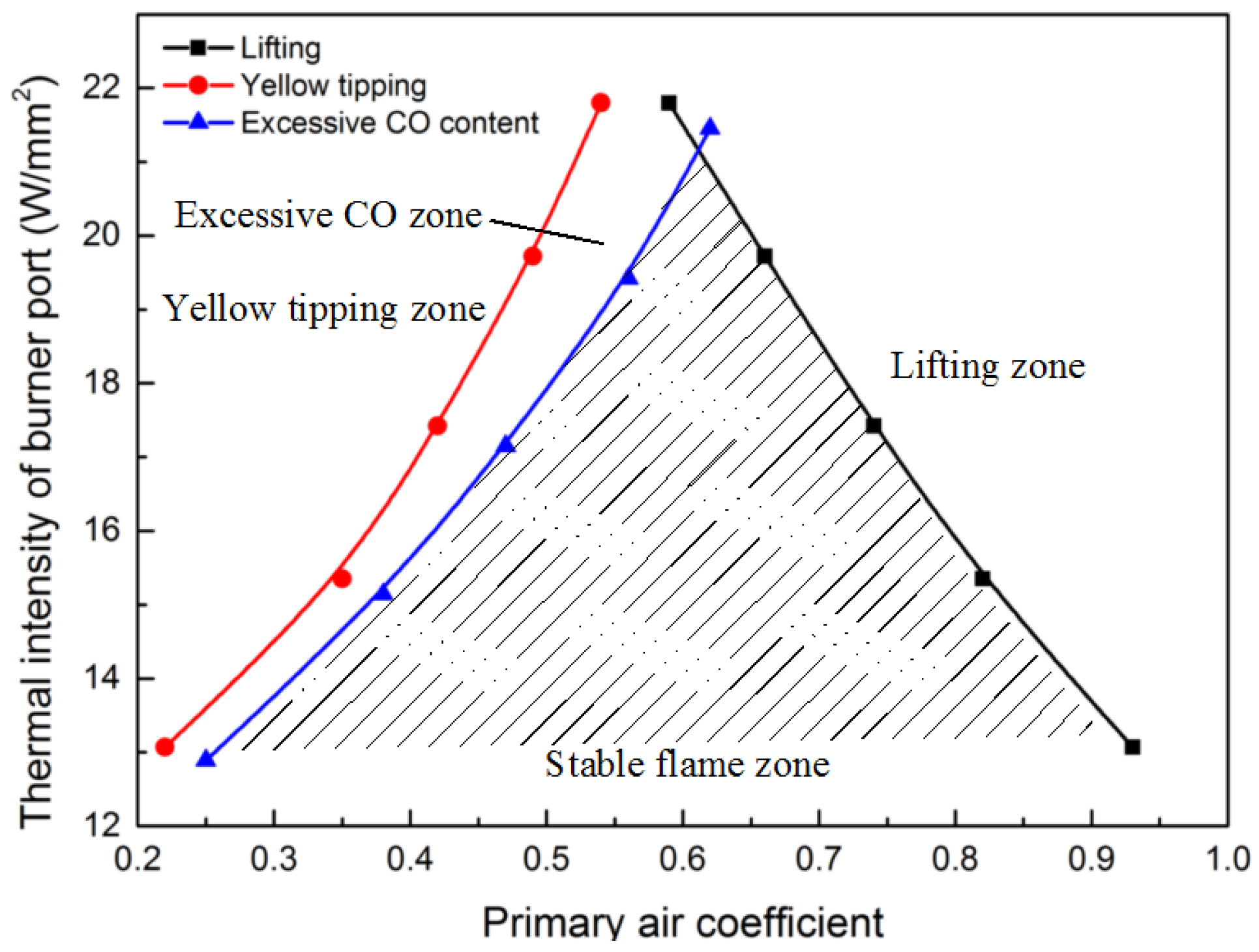
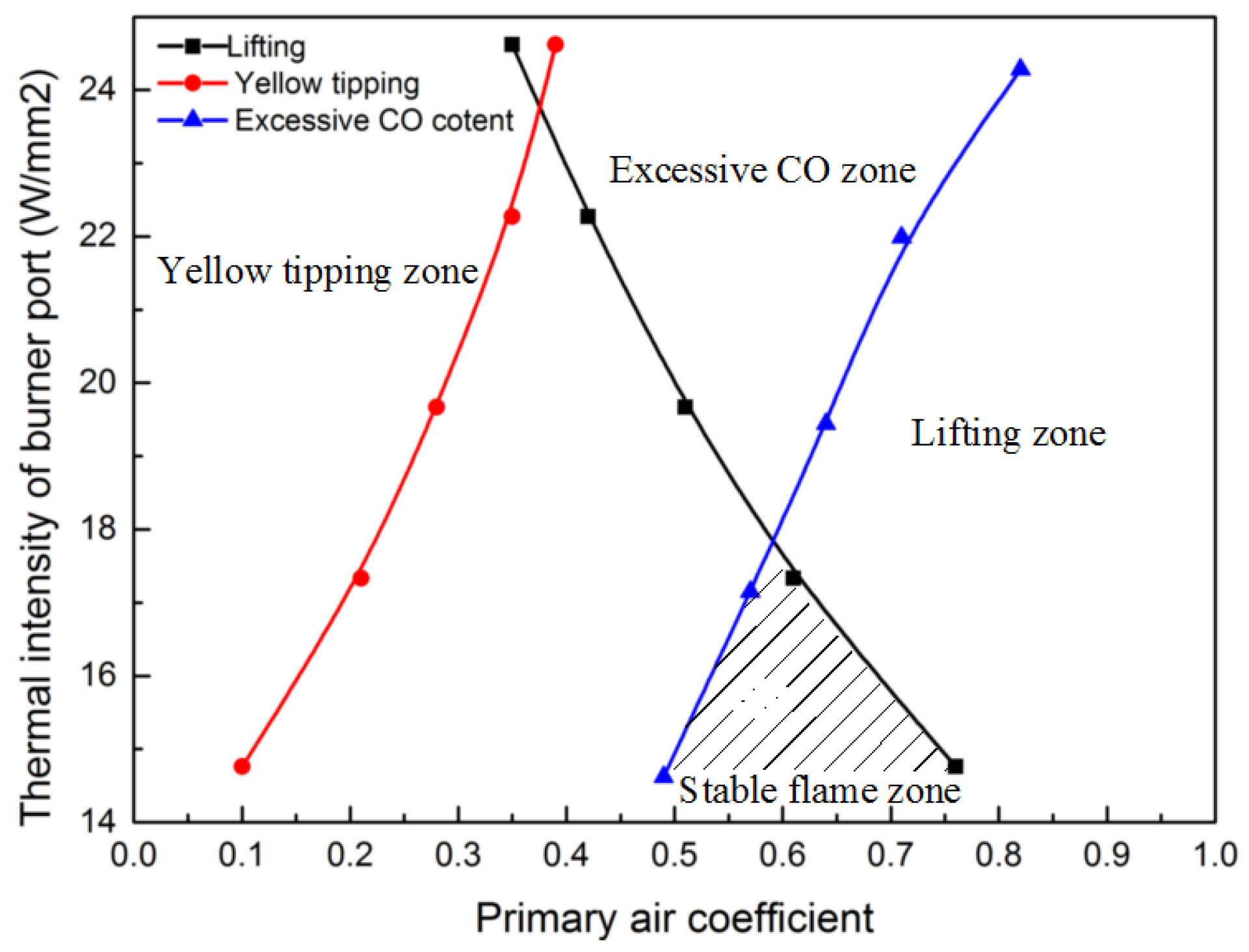
| Fuel Properties | 12T Reference Gas | 6T Reference Gas | Biogas | LNG |
|---|---|---|---|---|
| Methane (vol-%) | 100 | 53.40 | 60 | 99.70 |
| Ethane (vol-%) | 0 | 0 | 0 | 0.07 |
| Propane (vol-%) | 0 | 0 | 0 | 0.01 |
| C4 (vol-%) | 0 | 0 | 0 | 0 |
| C5 (vol-%) | 0 | 0 | 0 | 0 |
| Hydrogen (vol-%) | 0 | 0 | 0 | 0 |
| Nitrogen (vol-%) | 0 | 46.60 | 0 | 0.15 |
| Oxygen (vol-%) | 0 | 0 | 0 | 0.02 |
| Carbon monoxide (vol-%) | 0 | 0 | 0 | 0 |
| Carbon dioxide (vol-%) | 0 | 0 | 40 | 0.05 |
| Helium (vol-%) | 0 | 0 | 0 | 0 |
| High heating value (MJ/m3) | 37.7680 | 20.1800 | 22.6610 | 37.7110 |
| Low heating value (MJ/m3) | 34.0331 | 18.1600 | 20.4198 | 35.8487 |
| Relative density | 0.5548 | 0.7470 | 0.9445 | 0.5560 |
| Higher Wobbe Index (MJ/m3) | 50.7040 | 23.3500 | 23.3167 | 50.5744 |
| Combustion Potential | 40.2754 | 18.5000 | 18.5210 | 40.2146 |
| Gas Specification | Explosive Limits of Methane/Air Mixture | |
|---|---|---|
| LEL | UEL | |
| Methane (60%) + CO2 (40%) | 8.22 | 24.18 |
| Methane (49%) + air (51%) | 10.41 | 30.61 |
| Methane (53%) + air (47%) | 9.62 | 28.30 |
| Items | Value |
|---|---|
| Injection pressure ratio | 0.2 |
| Critical pressure ratio | 0.5 |
| Nozzle mouth area (mm2) | 2.6 |
| Emanation entrance diameter (mm) | 6.2 |
| Nozzle diameter (mm) | 1.8 |
| Cited emanation entrance diameter (mm) | 10.9 |
| Area of nozzle throat (mm) | 8.3 |
| Ejector diameter(mm) | 16.7 |
| Diffuser outlet cross section diameter (mm) | 13.2 |
| Distance of nozzle mouth section to throat section (mm) | 14.7 |
| Mixing length (mm) | 50.0 |
| Diffuser length (mm) | 39.5 |
| Mixer gas supply pressure (Pa) | 113278.7 |
| Recovery static pressure in diffuser (Pa) | 10817.9 |
| Static pressure recovery coefficient in diffuser | 1.9 |
| Parameters | Figure |
|---|---|
| Type | JZZ-Double ring burner |
| Nominal working pressure | 1.6 kPa |
| Nominal heat load | 3.26 kW |
| Thermal efficiency | ≥57% |
| Pipe interface size | 9.5 mm |
| Port width (mm) | 0.56 mm |
| Number of ports | Inner ring cap: 14 Outer ring cap: 31 |
| Area of single port (mm2) | Inner ring cap: 4.48 Outer ring cap: 5.83 |
| Test Items | Value | |||||
|---|---|---|---|---|---|---|
| Atmospheric pressure (kPa) | 99.27 | |||||
| Relative humidity (%) | 77.00 | |||||
| Gas components (vol-%) | 47% air + 53% methane | |||||
| Oven former pressure (kPa) | 0.80 | 1.00 | 1.20 | 1.40 | 1.60 | |
| Gas temperature (°C) | 12.00 | 12.00 | 12.00 | 12.00 | 12.00 | |
| Saturated steam pressure (kPa) | 1.07 | 1.07 | 1.07 | 1.07 | 1.07 | |
| Gas volume flow (m3/h) | 0.58 | 0.68 | 0.77 | 0.87 | 0.96 | |
| Actual heat input (kW) | 3.18 | 3.74 | 4.24 | 4.80 | 5.31 | |
| Thermal intensity of burner port (W/mm2) | 13.07 | 15.35 | 17.42 | 19.72 | 21.80 | |
| Lifting | O2 content in mixed gas (%) | 18.96 | 18.75 | 18.58 | 18.34 | 18.11 |
| Primary air coefficient | 0.93 | 0.82 | 0.74 | 0.66 | 0.59 | |
| Yellow tipping | O2 content in mixed gas (%) | 15.63 | 16.89 | 17.37 | 17.72 | 17.94 |
| Primary air coefficient | 0.22 | 0.35 | 0.42 | 0.49 | 0.54 | |
| Test Items | Value | ||||
|---|---|---|---|---|---|
| Atmospheric pressure (kPa) | 99.35 | ||||
| Relative humidity (%) | 66.00 | ||||
| Gas components (vol-%) | 47% air + 53% methane | ||||
| CO2 content in air (%) | 0 | ||||
| Oven former pressure (kPa) | 0.80 | 1.00 | 1.20 | 1.40 | 1.60 |
| Gas temperature (°C) | 13.40 | 13.50 | 13.90 | 13.80 | 14.00 |
| Saturated steam pressure (kPa) | 1.02 | 1.02 | 1.05 | 1.04 | 1.06 |
| Gas volume flow (m3/h) | 0.58 | 0.68 | 0.77 | 0.87 | 0.96 |
| Actual heat input (kW) | 3.14 | 3.69 | 4.17 | 4.73 | 5.22 |
| Thermal intensity of burner port(W/mm2) | 12.89 | 15.14 | 17.15 | 19.42 | 21.45 |
| O2 content in mixed gas (%) | 16.02 | 17.09 | 17.65 | 18.02 | 18.24 |
| Primary air coefficient | 0.25 | 0.38 | 0.47 | 0.56 | 0.62 |
| CO2 content in dry flue gas (%) | 6.21 | 6.54 | 6.92 | 7.06 | 7.19 |
| CO content in dry flue gas (ppm) | 3.00 | 3.00 | 3.00 | 3.00 | 3.00 |
| CO content in dry flue gas (%, primary air coefficient is 1) | 0.0567 | 0.0538 | 0.0509 | 0.0499 | 0.0490 |
| Test Items | Value | |||||
|---|---|---|---|---|---|---|
| Atmospheric pressure (kPa) | 99.03 | |||||
| Relative humidity (%) | 64.00 | |||||
| Gas components (vol-%) | 41% air + 59% methane | |||||
| Oven former pressure (kPa) | 0.80 | 1.00 | 1.20 | 1.40 | 1.60 | |
| Gas temperature (°C) | 12.70 | 12.70 | 12.70 | 12.70 | 12.70 | |
| Saturated steam pressure (kPa) | 0.95 | 0.95 | 0.95 | 0.95 | 0.95 | |
| Gas volume flow (m3/h) | 0.58 | 0.68 | 0.77 | 0.87 | 0.96 | |
| Actual heat input (kW) | 3.59 | 4.22 | 4.79 | 5.42 | 5.99 | |
| Thermal intensity of burner port (W/mm2) | 14.76 | 17.33 | 19.67 | 22.27 | 24.62 | |
| Lifting | O2 content in mixed gas (%) | 18.57 | 18.11 | 17.69 | 17.25 | 16.73 |
| Primary air coefficient | 0.76 | 0.61 | 0.51 | 0.42 | 0.35 | |
| Yellow tipping | O2 content in mixed gas (%) | 12.86 | 15.27 | 16.13 | 16.71 | 17.05 |
| Primary air coefficient | 0.10 | 0.21 | 0.28 | 0.35 | 0.39 | |
| Test Items | Value | ||||
|---|---|---|---|---|---|
| Atmospheric pressure (kPa) | 99.52 | ||||
| Relative humidity (%) | 79.00 | ||||
| Gas components (vol-%) | 41% air + 59% methane | ||||
| CO2 content in air (%) | 0 | ||||
| Oven former pressure (kPa) | 0.80 | 1.00 | 1.20 | 1.40 | 1.60 |
| Gas temperature (°C) | 13.20 | 13.50 | 13.80 | 14.00 | 14.30 |
| Saturated steam pressure (kPa) | 1.17 | 1.20 | 1.23 | 1.25 | 1.28 |
| Gas volume flow (m3/h) | 0.58 | 0.68 | 0.77 | 0.87 | 0.96 |
| Actual heat input (kW) | 3.56 | 4.18 | 4.73 | 5.35 | 5.91 |
| Thermal intensity of burner port (W/mm2) | 14.62 | 17.15 | 19.44 | 21.99 | 24.28 |
| O2 content in mixed gas (%) | 17.59 | 17.98 | 18.21 | 18.43 | 18.69 |
| Primary air coefficient | 0.49 | 0.57 | 0.64 | 0.71 | 0.82 |
| CO2 content in dry flue gas (%) | 8.12 | 8.26 | 8.41 | 8.58 | 8.67 |
| CO content in dry flue gas (ppm) | 4.00 | 4.00 | 4.00 | 4.00 | 4.00 |
| CO content in dry flue gas (%, primary air coefficient is 1) | 0.0578 | 0.0568 | 0.0558 | 0.0547 | 0.0542 |
© 2017 by the authors. Licensee MDPI, Basel, Switzerland. This article is an open access article distributed under the terms and conditions of the Creative Commons Attribution (CC BY) license (http://creativecommons.org/licenses/by/4.0/).
Share and Cite
Zhou, Y.; Peng, S.; Huang, X.; Wu, C.; Zhang, J. LNG–Air Mixture as a Supplementary Energy Injection into a Biogas Distribution Network. Energies 2017, 10, 1902. https://doi.org/10.3390/en10111902
Zhou Y, Peng S, Huang X, Wu C, Zhang J. LNG–Air Mixture as a Supplementary Energy Injection into a Biogas Distribution Network. Energies. 2017; 10(11):1902. https://doi.org/10.3390/en10111902
Chicago/Turabian StyleZhou, Yang, Shini Peng, Xiaomei Huang, Chang Wu, and Jing Zhang. 2017. "LNG–Air Mixture as a Supplementary Energy Injection into a Biogas Distribution Network" Energies 10, no. 11: 1902. https://doi.org/10.3390/en10111902
APA StyleZhou, Y., Peng, S., Huang, X., Wu, C., & Zhang, J. (2017). LNG–Air Mixture as a Supplementary Energy Injection into a Biogas Distribution Network. Energies, 10(11), 1902. https://doi.org/10.3390/en10111902





